Microeconomic Theory Assignment: Competitive Markets & Oligopoly
VerifiedAdded on 2022/07/28
|12
|1163
|23
Homework Assignment
AI Summary
This assignment solution addresses several key concepts in microeconomic theory. It begins by analyzing long-run equilibrium in a perfectly competitive market, deriving output, price, and the number of firms. The solution then explores a scenario with given market demand and marginal cost to determine equilibrium values. A case study examines the calcium market, tracing price fluctuations and explaining them through supply and demand dynamics. The assignment further delves into monopoly, calculating profit-maximizing output and price. It also tackles oligopoly using the Cournot model, analyzing firm behavior and first-mover advantages. Additionally, the solution covers market equilibrium, price elasticity, tax burden, and game theory concepts like backward induction and sequential games, providing a comprehensive understanding of microeconomic principles.

Paraphrase This Document
Need a fresh take? Get an instant paraphrase of this document with our AI Paraphraser
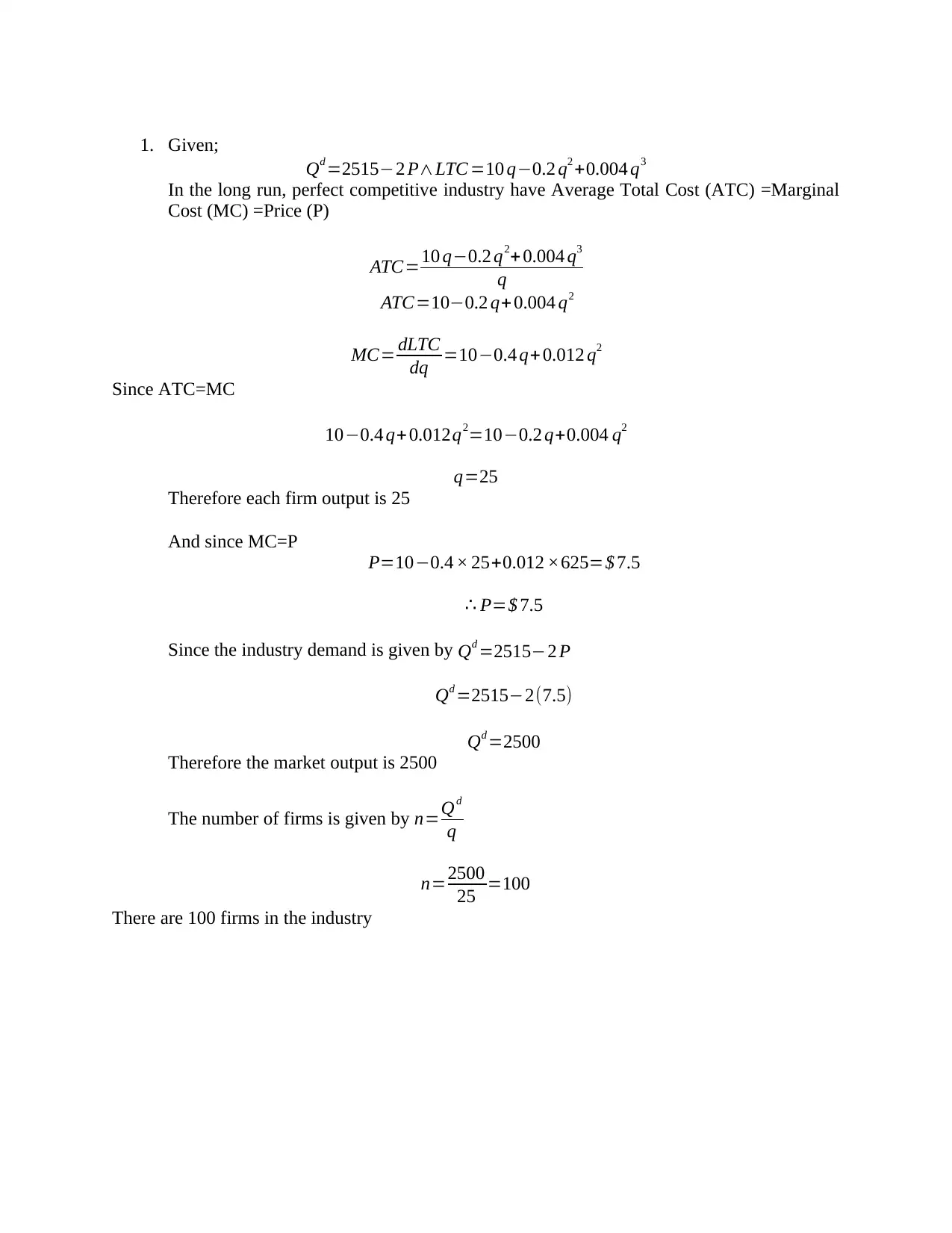
1. Given;
Qd =2515−2 P∧LTC =10 q−0.2 q2 +0.004 q3
In the long run, perfect competitive industry have Average Total Cost (ATC) =Marginal
Cost (MC) =Price (P)
ATC=10 q−0.2 q2+ 0.004 q3
q
ATC=10−0.2 q+ 0.004 q2
MC= dLTC
dq =10−0.4 q+ 0.012 q2
Since ATC=MC
10−0.4 q+ 0.012q2=10−0.2 q+0.004 q2
q=25
Therefore each firm output is 25
And since MC=P
P=10−0.4 × 25+0.012 ×625=$ 7.5
∴ P=$ 7.5
Since the industry demand is given by Qd =2515−2 P
Qd =2515−2(7.5)
Qd =2500
Therefore the market output is 2500
The number of firms is given by n=Qd
q
n=2500
25 =100
There are 100 firms in the industry
Qd =2515−2 P∧LTC =10 q−0.2 q2 +0.004 q3
In the long run, perfect competitive industry have Average Total Cost (ATC) =Marginal
Cost (MC) =Price (P)
ATC=10 q−0.2 q2+ 0.004 q3
q
ATC=10−0.2 q+ 0.004 q2
MC= dLTC
dq =10−0.4 q+ 0.012 q2
Since ATC=MC
10−0.4 q+ 0.012q2=10−0.2 q+0.004 q2
q=25
Therefore each firm output is 25
And since MC=P
P=10−0.4 × 25+0.012 ×625=$ 7.5
∴ P=$ 7.5
Since the industry demand is given by Qd =2515−2 P
Qd =2515−2(7.5)
Qd =2500
Therefore the market output is 2500
The number of firms is given by n=Qd
q
n=2500
25 =100
There are 100 firms in the industry
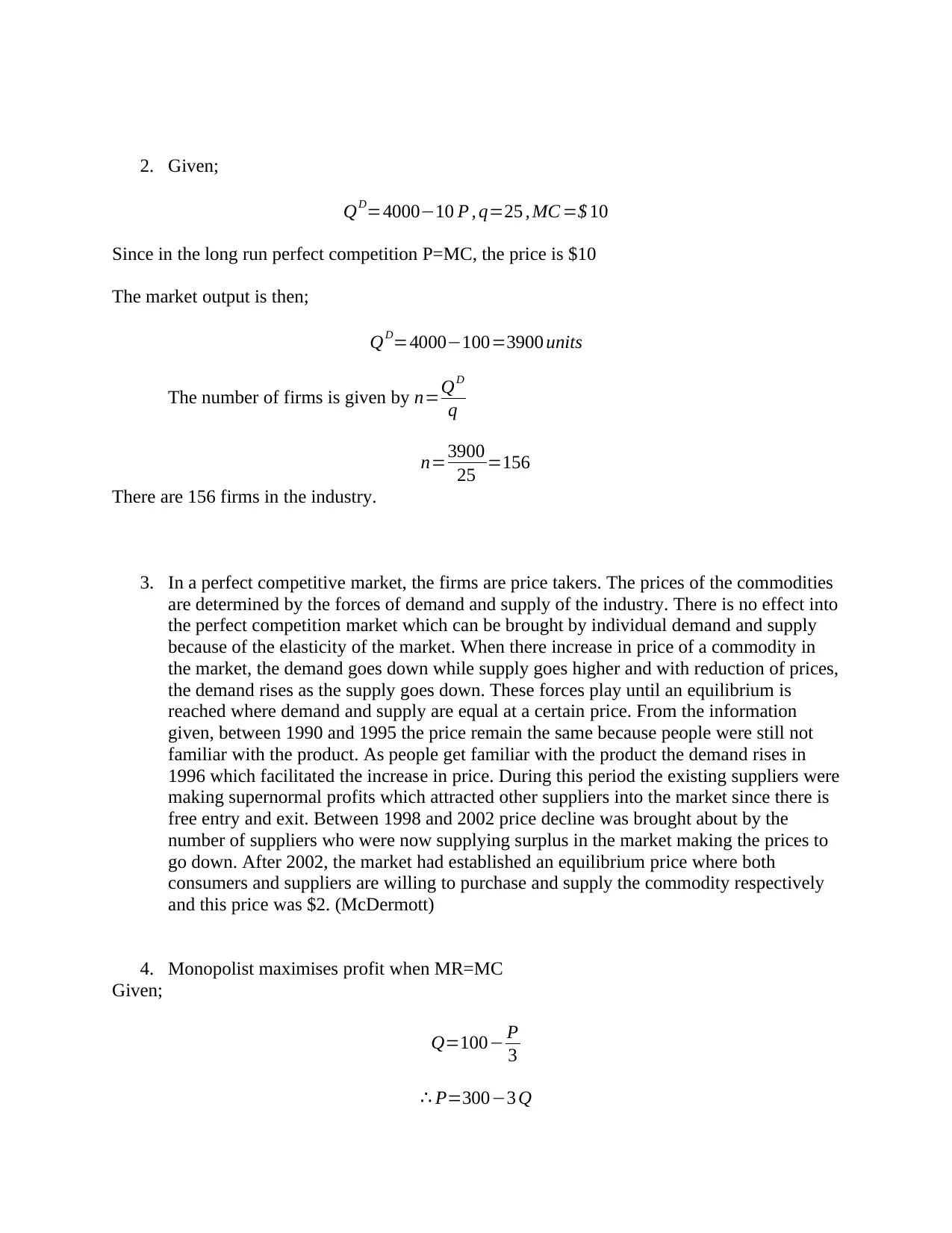
2. Given;
QD=4000−10 P , q=25 , MC =$ 10
Since in the long run perfect competition P=MC, the price is $10
The market output is then;
QD=4000−100=3900 units
The number of firms is given by n=QD
q
n=3900
25 =156
There are 156 firms in the industry.
3. In a perfect competitive market, the firms are price takers. The prices of the commodities
are determined by the forces of demand and supply of the industry. There is no effect into
the perfect competition market which can be brought by individual demand and supply
because of the elasticity of the market. When there increase in price of a commodity in
the market, the demand goes down while supply goes higher and with reduction of prices,
the demand rises as the supply goes down. These forces play until an equilibrium is
reached where demand and supply are equal at a certain price. From the information
given, between 1990 and 1995 the price remain the same because people were still not
familiar with the product. As people get familiar with the product the demand rises in
1996 which facilitated the increase in price. During this period the existing suppliers were
making supernormal profits which attracted other suppliers into the market since there is
free entry and exit. Between 1998 and 2002 price decline was brought about by the
number of suppliers who were now supplying surplus in the market making the prices to
go down. After 2002, the market had established an equilibrium price where both
consumers and suppliers are willing to purchase and supply the commodity respectively
and this price was $2. (McDermott)
4. Monopolist maximises profit when MR=MC
Given;
Q=100− P
3
∴ P=300−3 Q
QD=4000−10 P , q=25 , MC =$ 10
Since in the long run perfect competition P=MC, the price is $10
The market output is then;
QD=4000−100=3900 units
The number of firms is given by n=QD
q
n=3900
25 =156
There are 156 firms in the industry.
3. In a perfect competitive market, the firms are price takers. The prices of the commodities
are determined by the forces of demand and supply of the industry. There is no effect into
the perfect competition market which can be brought by individual demand and supply
because of the elasticity of the market. When there increase in price of a commodity in
the market, the demand goes down while supply goes higher and with reduction of prices,
the demand rises as the supply goes down. These forces play until an equilibrium is
reached where demand and supply are equal at a certain price. From the information
given, between 1990 and 1995 the price remain the same because people were still not
familiar with the product. As people get familiar with the product the demand rises in
1996 which facilitated the increase in price. During this period the existing suppliers were
making supernormal profits which attracted other suppliers into the market since there is
free entry and exit. Between 1998 and 2002 price decline was brought about by the
number of suppliers who were now supplying surplus in the market making the prices to
go down. After 2002, the market had established an equilibrium price where both
consumers and suppliers are willing to purchase and supply the commodity respectively
and this price was $2. (McDermott)
4. Monopolist maximises profit when MR=MC
Given;
Q=100− P
3
∴ P=300−3 Q
⊘ This is a preview!⊘
Do you want full access?
Subscribe today to unlock all pages.

Trusted by 1+ million students worldwide
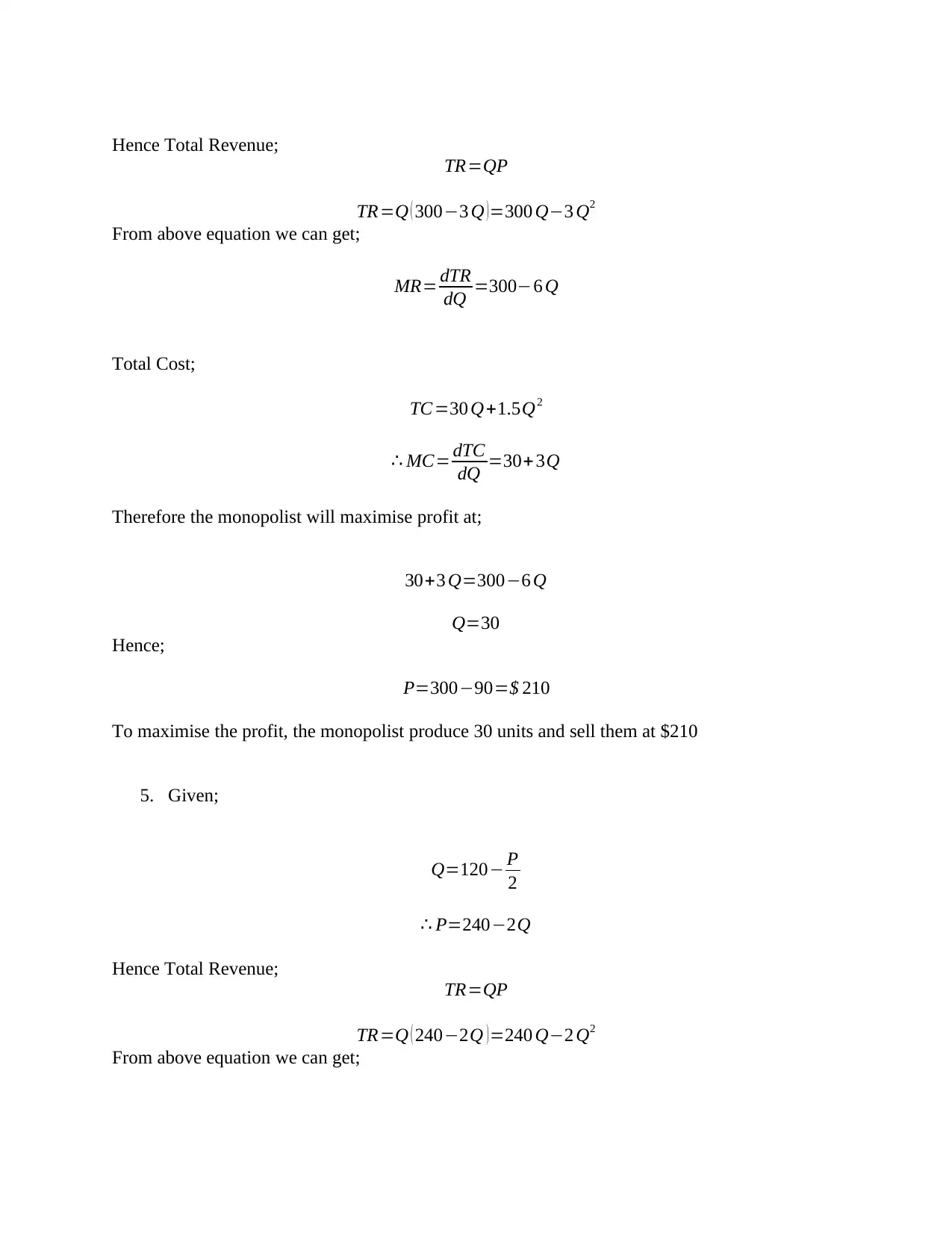
Hence Total Revenue;
TR=QP
TR=Q ( 300−3 Q )=300 Q−3 Q2
From above equation we can get;
MR= dTR
dQ =300−6 Q
Total Cost;
TC=30 Q+1.5Q2
∴ MC= dTC
dQ =30+ 3Q
Therefore the monopolist will maximise profit at;
30+3 Q=300−6 Q
Q=30
Hence;
P=300−90=$ 210
To maximise the profit, the monopolist produce 30 units and sell them at $210
5. Given;
Q=120− P
2
∴ P=240−2Q
Hence Total Revenue;
TR=QP
TR=Q ( 240−2Q )=240 Q−2 Q2
From above equation we can get;
TR=QP
TR=Q ( 300−3 Q )=300 Q−3 Q2
From above equation we can get;
MR= dTR
dQ =300−6 Q
Total Cost;
TC=30 Q+1.5Q2
∴ MC= dTC
dQ =30+ 3Q
Therefore the monopolist will maximise profit at;
30+3 Q=300−6 Q
Q=30
Hence;
P=300−90=$ 210
To maximise the profit, the monopolist produce 30 units and sell them at $210
5. Given;
Q=120− P
2
∴ P=240−2Q
Hence Total Revenue;
TR=QP
TR=Q ( 240−2Q )=240 Q−2 Q2
From above equation we can get;
Paraphrase This Document
Need a fresh take? Get an instant paraphrase of this document with our AI Paraphraser
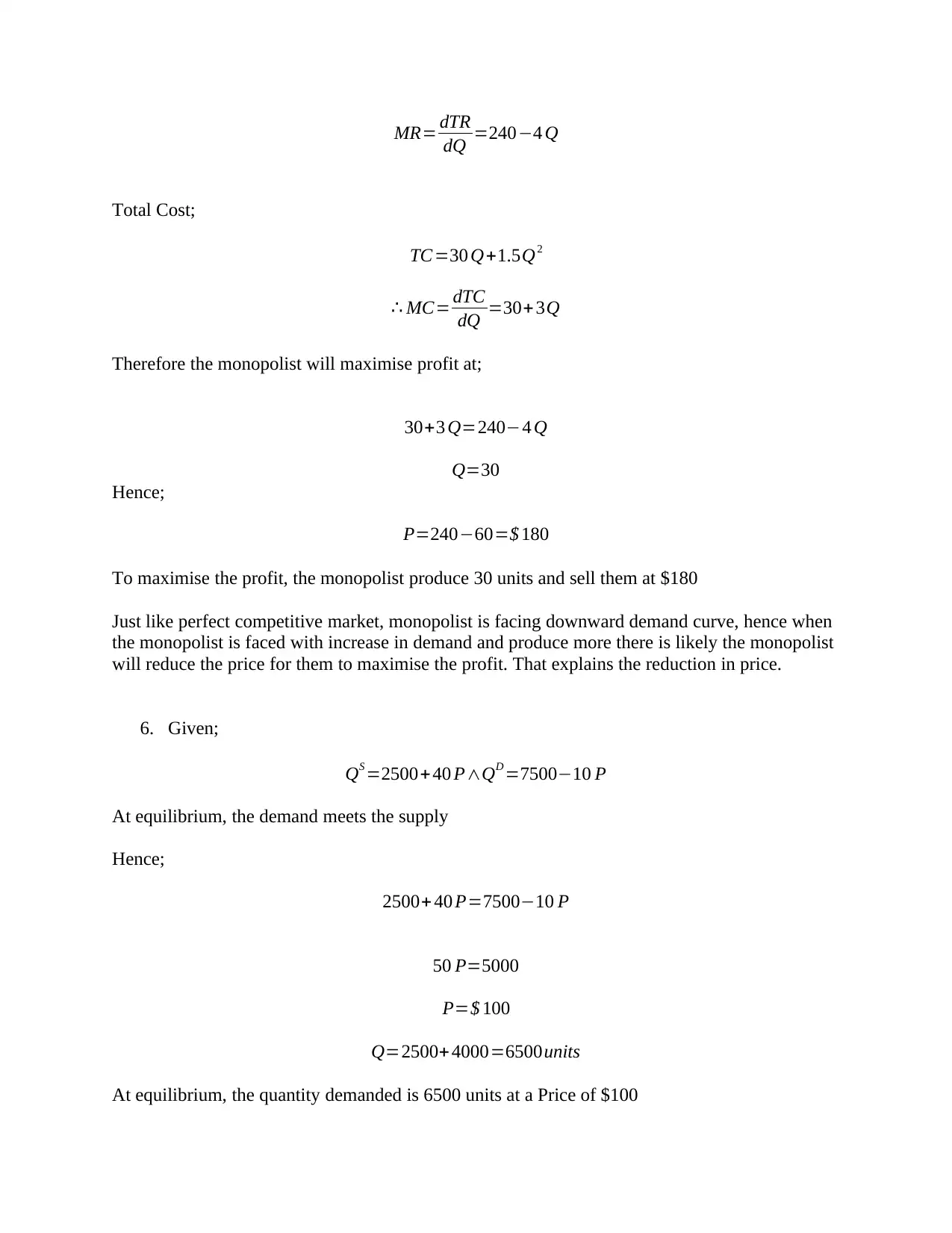
MR= dTR
dQ =240−4 Q
Total Cost;
TC=30 Q+1.5Q2
∴ MC= dTC
dQ =30+ 3Q
Therefore the monopolist will maximise profit at;
30+3 Q=240−4 Q
Q=30
Hence;
P=240−60=$ 180
To maximise the profit, the monopolist produce 30 units and sell them at $180
Just like perfect competitive market, monopolist is facing downward demand curve, hence when
the monopolist is faced with increase in demand and produce more there is likely the monopolist
will reduce the price for them to maximise the profit. That explains the reduction in price.
6. Given;
QS =2500+ 40 P∧QD =7500−10 P
At equilibrium, the demand meets the supply
Hence;
2500+ 40 P=7500−10 P
50 P=5000
P=$ 100
Q=2500+ 4000=6500units
At equilibrium, the quantity demanded is 6500 units at a Price of $100
dQ =240−4 Q
Total Cost;
TC=30 Q+1.5Q2
∴ MC= dTC
dQ =30+ 3Q
Therefore the monopolist will maximise profit at;
30+3 Q=240−4 Q
Q=30
Hence;
P=240−60=$ 180
To maximise the profit, the monopolist produce 30 units and sell them at $180
Just like perfect competitive market, monopolist is facing downward demand curve, hence when
the monopolist is faced with increase in demand and produce more there is likely the monopolist
will reduce the price for them to maximise the profit. That explains the reduction in price.
6. Given;
QS =2500+ 40 P∧QD =7500−10 P
At equilibrium, the demand meets the supply
Hence;
2500+ 40 P=7500−10 P
50 P=5000
P=$ 100
Q=2500+ 4000=6500units
At equilibrium, the quantity demanded is 6500 units at a Price of $100
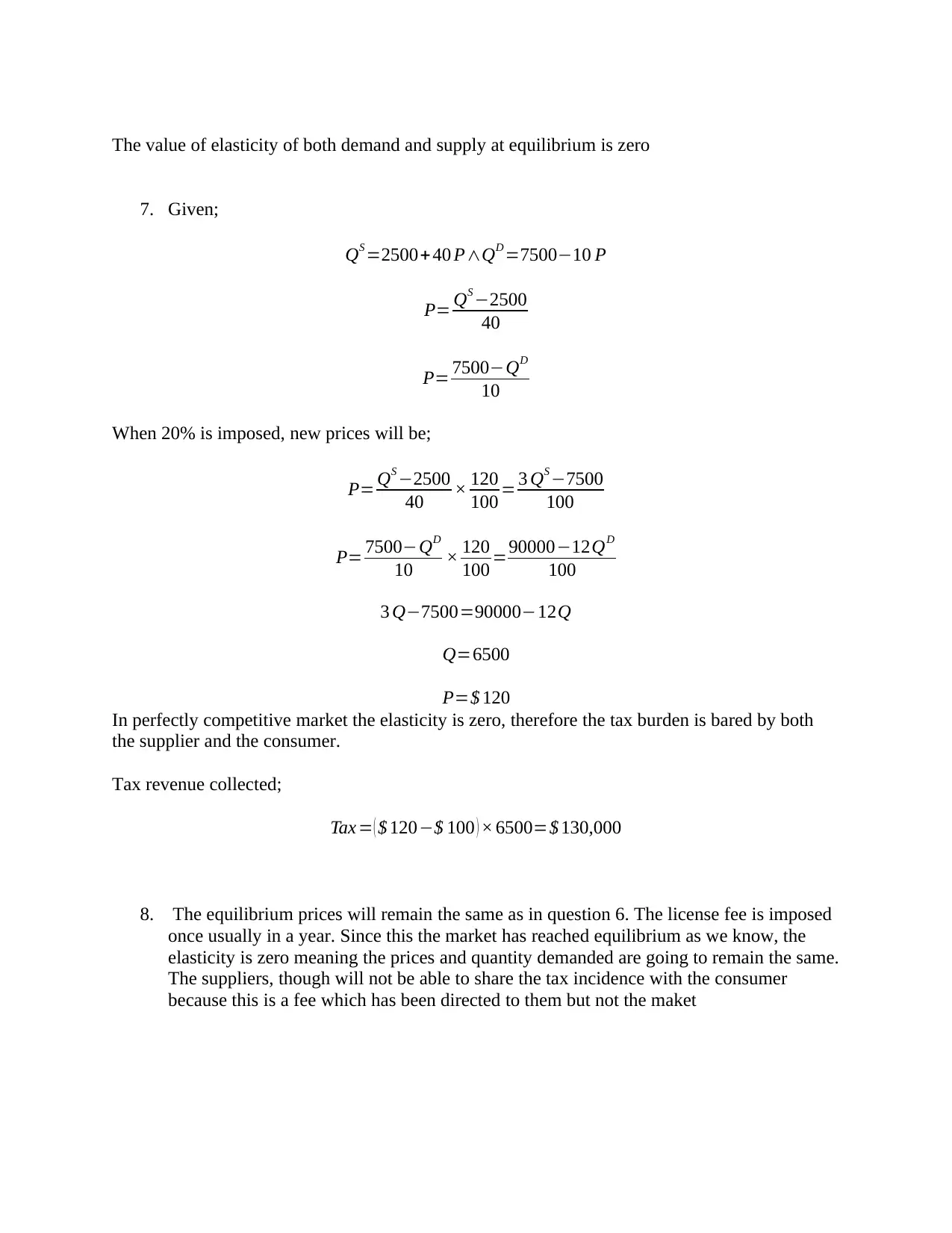
The value of elasticity of both demand and supply at equilibrium is zero
7. Given;
QS =2500+ 40 P∧QD =7500−10 P
P= QS −2500
40
P= 7500−QD
10
When 20% is imposed, new prices will be;
P= QS −2500
40 × 120
100 = 3 QS −7500
100
P= 7500−QD
10 × 120
100 =90000−12QD
100
3 Q−7500=90000−12Q
Q=6500
P=$ 120
In perfectly competitive market the elasticity is zero, therefore the tax burden is bared by both
the supplier and the consumer.
Tax revenue collected;
Tax = ( $ 120−$ 100 ) × 6500=$ 130,000
8. The equilibrium prices will remain the same as in question 6. The license fee is imposed
once usually in a year. Since this the market has reached equilibrium as we know, the
elasticity is zero meaning the prices and quantity demanded are going to remain the same.
The suppliers, though will not be able to share the tax incidence with the consumer
because this is a fee which has been directed to them but not the maket
7. Given;
QS =2500+ 40 P∧QD =7500−10 P
P= QS −2500
40
P= 7500−QD
10
When 20% is imposed, new prices will be;
P= QS −2500
40 × 120
100 = 3 QS −7500
100
P= 7500−QD
10 × 120
100 =90000−12QD
100
3 Q−7500=90000−12Q
Q=6500
P=$ 120
In perfectly competitive market the elasticity is zero, therefore the tax burden is bared by both
the supplier and the consumer.
Tax revenue collected;
Tax = ( $ 120−$ 100 ) × 6500=$ 130,000
8. The equilibrium prices will remain the same as in question 6. The license fee is imposed
once usually in a year. Since this the market has reached equilibrium as we know, the
elasticity is zero meaning the prices and quantity demanded are going to remain the same.
The suppliers, though will not be able to share the tax incidence with the consumer
because this is a fee which has been directed to them but not the maket
⊘ This is a preview!⊘
Do you want full access?
Subscribe today to unlock all pages.

Trusted by 1+ million students worldwide
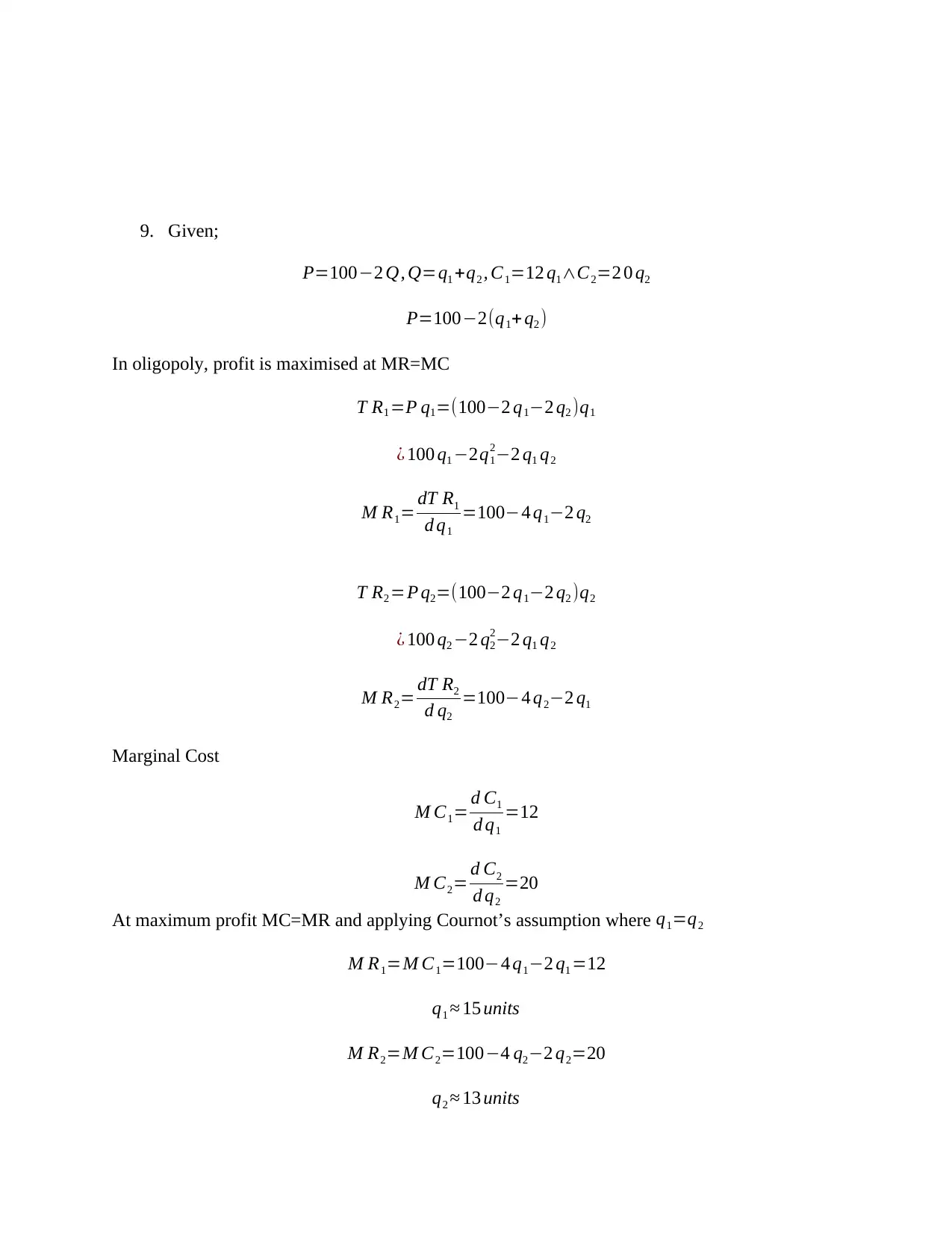
9. Given;
P=100−2 Q, Q=q1 +q2 , C1=12 q1∧C2=2 0 q2
P=100−2(q1+ q2 )
In oligopoly, profit is maximised at MR=MC
T R1 =P q1=(100−2 q1−2 q2 )q1
¿ 100 q1 −2q1
2−2 q1 q2
M R1= dT R1
d q1
=100−4 q1−2 q2
T R2 =P q2=(100−2 q1−2 q2 )q2
¿ 100 q2 −2 q2
2−2 q1 q2
M R2= dT R2
d q2
=100−4 q2−2 q1
Marginal Cost
M C1= d C1
d q1
=12
M C2= d C2
d q2
=20
At maximum profit MC=MR and applying Cournot’s assumption where q1=q2
M R1=M C1=100−4 q1−2 q1 =12
q1 ≈ 15 units
M R2=M C2=100−4 q2−2 q2=20
q2 ≈ 13 units
P=100−2 Q, Q=q1 +q2 , C1=12 q1∧C2=2 0 q2
P=100−2(q1+ q2 )
In oligopoly, profit is maximised at MR=MC
T R1 =P q1=(100−2 q1−2 q2 )q1
¿ 100 q1 −2q1
2−2 q1 q2
M R1= dT R1
d q1
=100−4 q1−2 q2
T R2 =P q2=(100−2 q1−2 q2 )q2
¿ 100 q2 −2 q2
2−2 q1 q2
M R2= dT R2
d q2
=100−4 q2−2 q1
Marginal Cost
M C1= d C1
d q1
=12
M C2= d C2
d q2
=20
At maximum profit MC=MR and applying Cournot’s assumption where q1=q2
M R1=M C1=100−4 q1−2 q1 =12
q1 ≈ 15 units
M R2=M C2=100−4 q2−2 q2=20
q2 ≈ 13 units
Paraphrase This Document
Need a fresh take? Get an instant paraphrase of this document with our AI Paraphraser
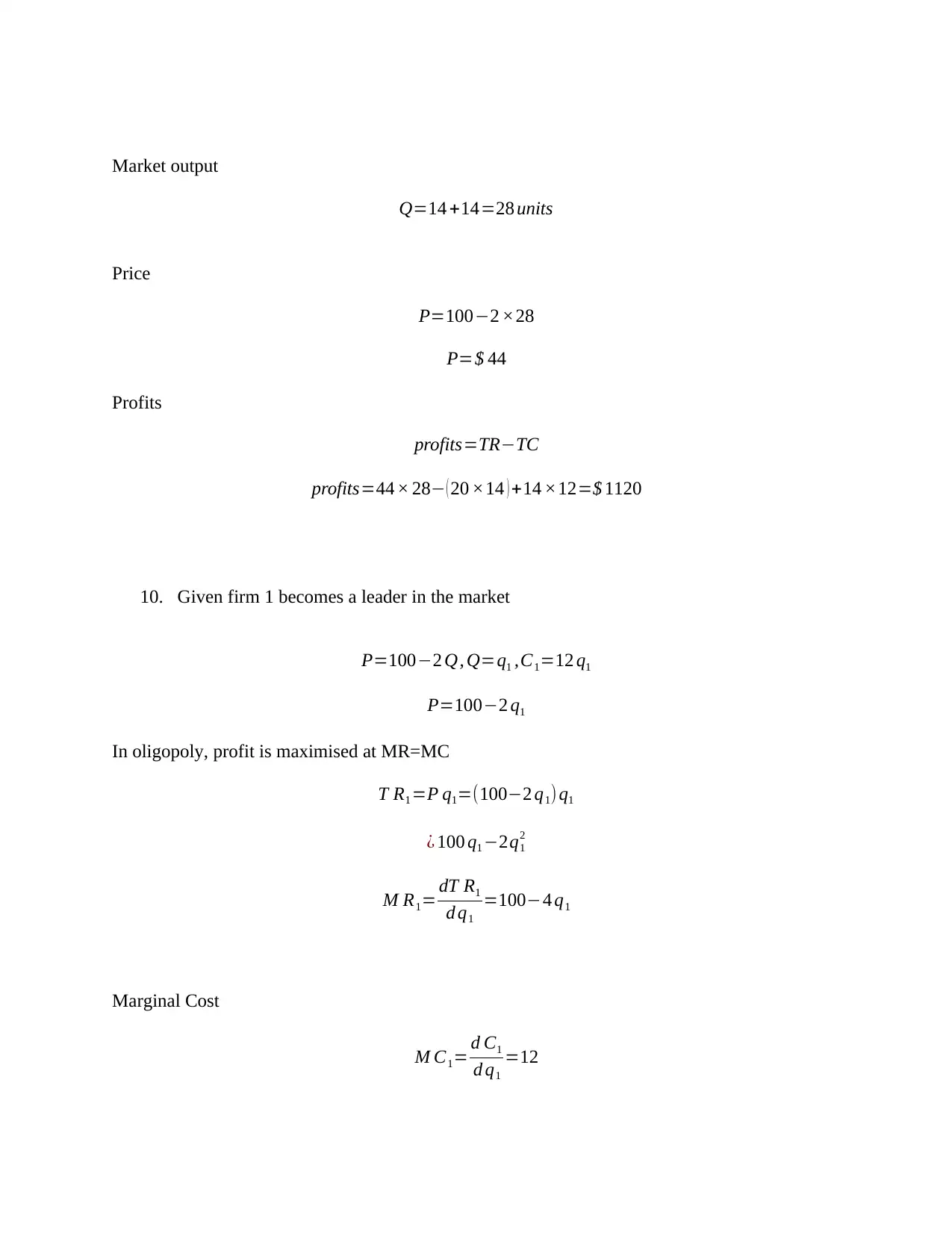
Market output
Q=14 +14=28 units
Price
P=100−2 ×28
P=$ 44
Profits
profits=TR−TC
profits=44 × 28− ( 20 ×14 ) +14 ×12=$ 1120
10. Given firm 1 becomes a leader in the market
P=100−2 Q, Q=q1 ,C1=12 q1
P=100−2 q1
In oligopoly, profit is maximised at MR=MC
T R1 =P q1=(100−2 q1) q1
¿ 100 q1 −2q1
2
M R1= dT R1
d q1
=100−4 q1
Marginal Cost
M C1= d C1
d q1
=12
Q=14 +14=28 units
Price
P=100−2 ×28
P=$ 44
Profits
profits=TR−TC
profits=44 × 28− ( 20 ×14 ) +14 ×12=$ 1120
10. Given firm 1 becomes a leader in the market
P=100−2 Q, Q=q1 ,C1=12 q1
P=100−2 q1
In oligopoly, profit is maximised at MR=MC
T R1 =P q1=(100−2 q1) q1
¿ 100 q1 −2q1
2
M R1= dT R1
d q1
=100−4 q1
Marginal Cost
M C1= d C1
d q1
=12
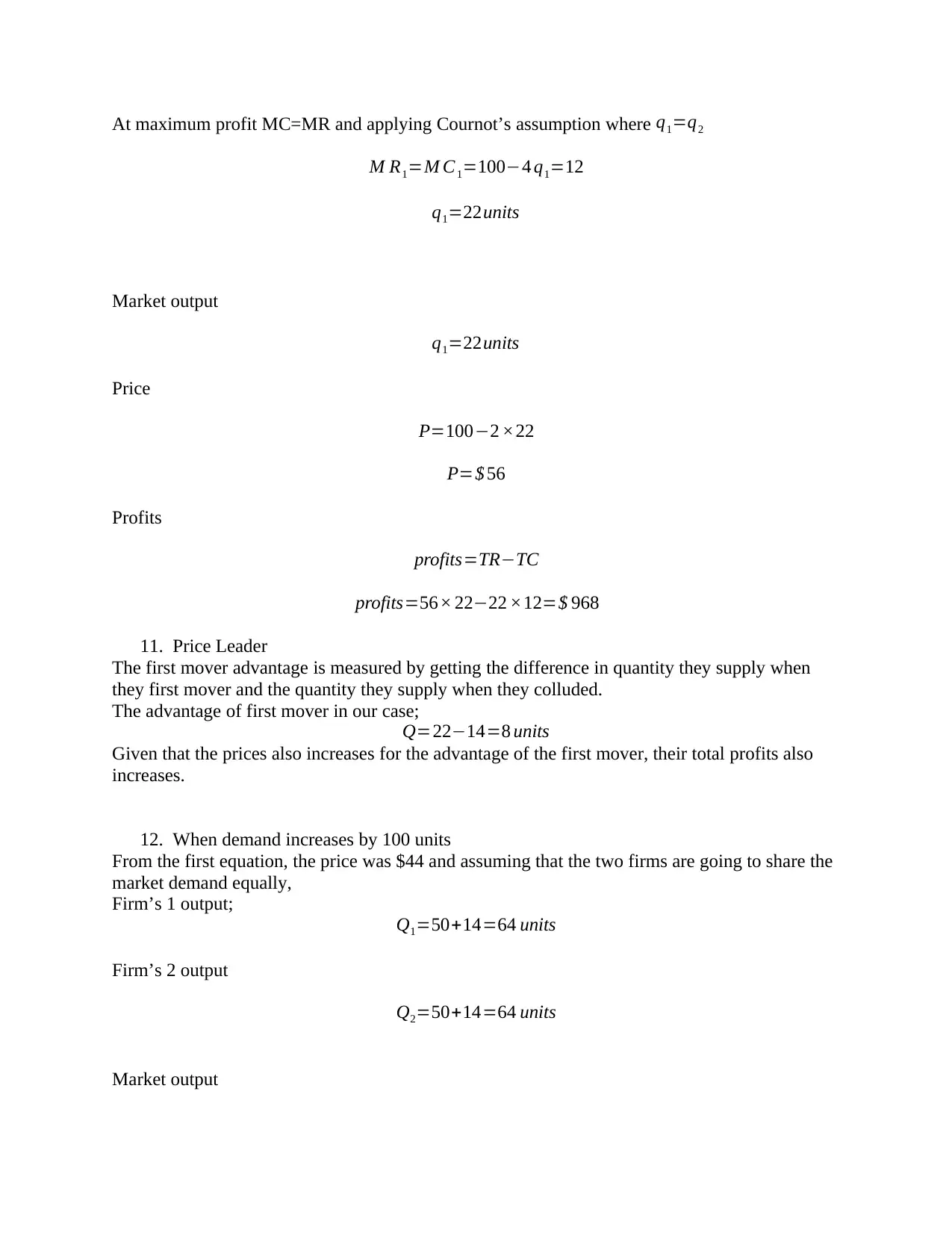
At maximum profit MC=MR and applying Cournot’s assumption where q1=q2
M R1=M C1=100−4 q1=12
q1=22units
Market output
q1=22units
Price
P=100−2 ×22
P=$ 56
Profits
profits=TR−TC
profits=56× 22−22 ×12=$ 968
11. Price Leader
The first mover advantage is measured by getting the difference in quantity they supply when
they first mover and the quantity they supply when they colluded.
The advantage of first mover in our case;
Q=22−14=8 units
Given that the prices also increases for the advantage of the first mover, their total profits also
increases.
12. When demand increases by 100 units
From the first equation, the price was $44 and assuming that the two firms are going to share the
market demand equally,
Firm’s 1 output;
Q1=50+14=64 units
Firm’s 2 output
Q2=50+14=64 units
Market output
M R1=M C1=100−4 q1=12
q1=22units
Market output
q1=22units
Price
P=100−2 ×22
P=$ 56
Profits
profits=TR−TC
profits=56× 22−22 ×12=$ 968
11. Price Leader
The first mover advantage is measured by getting the difference in quantity they supply when
they first mover and the quantity they supply when they colluded.
The advantage of first mover in our case;
Q=22−14=8 units
Given that the prices also increases for the advantage of the first mover, their total profits also
increases.
12. When demand increases by 100 units
From the first equation, the price was $44 and assuming that the two firms are going to share the
market demand equally,
Firm’s 1 output;
Q1=50+14=64 units
Firm’s 2 output
Q2=50+14=64 units
Market output
⊘ This is a preview!⊘
Do you want full access?
Subscribe today to unlock all pages.

Trusted by 1+ million students worldwide
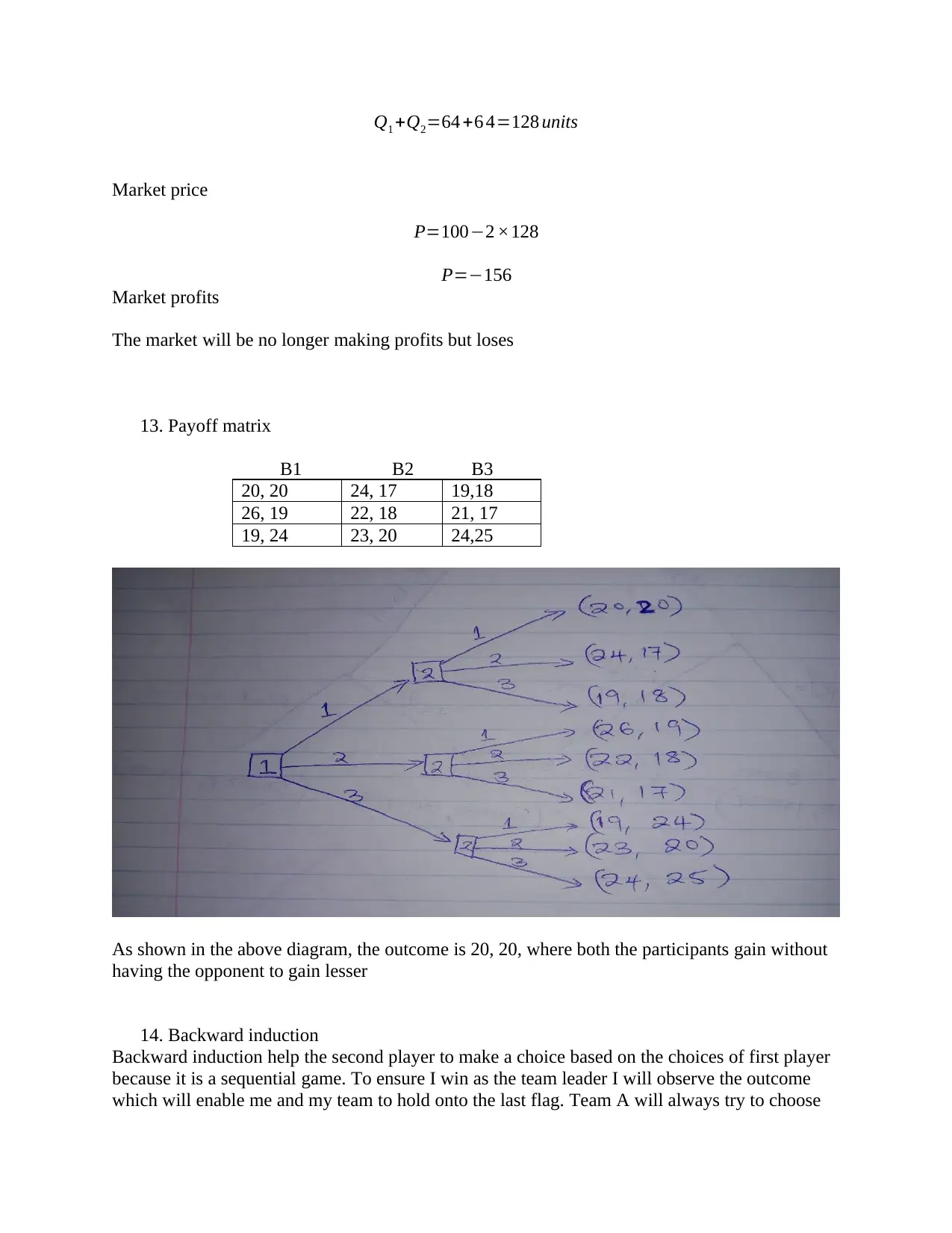
Q1 +Q2=64 +6 4=128 units
Market price
P=100−2 ×128
P=−156
Market profits
The market will be no longer making profits but loses
13. Payoff matrix
B1 B2 B3
20, 20 24, 17 19,18
26, 19 22, 18 21, 17
19, 24 23, 20 24,25
As shown in the above diagram, the outcome is 20, 20, where both the participants gain without
having the opponent to gain lesser
14. Backward induction
Backward induction help the second player to make a choice based on the choices of first player
because it is a sequential game. To ensure I win as the team leader I will observe the outcome
which will enable me and my team to hold onto the last flag. Team A will always try to choose
Market price
P=100−2 ×128
P=−156
Market profits
The market will be no longer making profits but loses
13. Payoff matrix
B1 B2 B3
20, 20 24, 17 19,18
26, 19 22, 18 21, 17
19, 24 23, 20 24,25
As shown in the above diagram, the outcome is 20, 20, where both the participants gain without
having the opponent to gain lesser
14. Backward induction
Backward induction help the second player to make a choice based on the choices of first player
because it is a sequential game. To ensure I win as the team leader I will observe the outcome
which will enable me and my team to hold onto the last flag. Team A will always try to choose
Paraphrase This Document
Need a fresh take? Get an instant paraphrase of this document with our AI Paraphraser
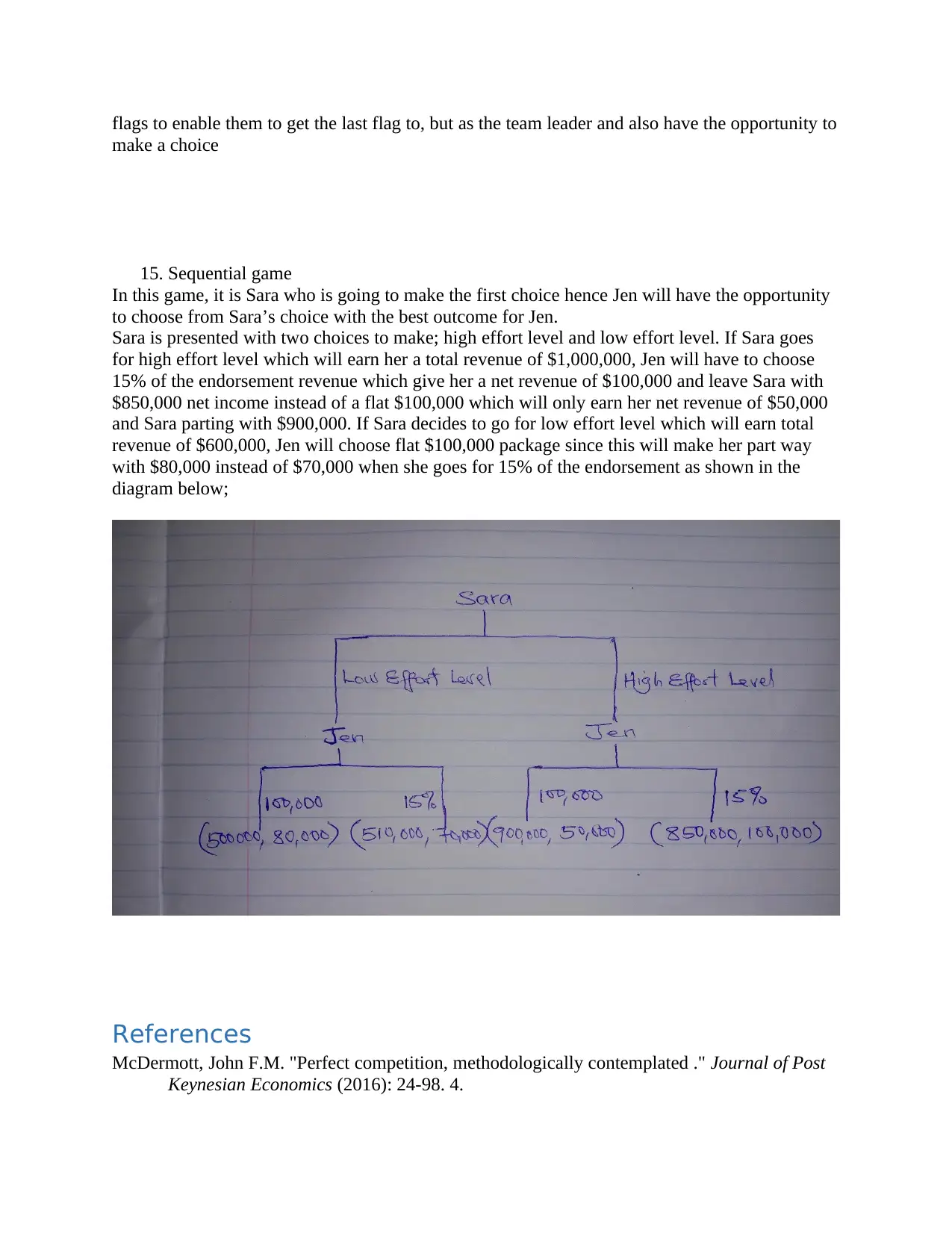
flags to enable them to get the last flag to, but as the team leader and also have the opportunity to
make a choice
15. Sequential game
In this game, it is Sara who is going to make the first choice hence Jen will have the opportunity
to choose from Sara’s choice with the best outcome for Jen.
Sara is presented with two choices to make; high effort level and low effort level. If Sara goes
for high effort level which will earn her a total revenue of $1,000,000, Jen will have to choose
15% of the endorsement revenue which give her a net revenue of $100,000 and leave Sara with
$850,000 net income instead of a flat $100,000 which will only earn her net revenue of $50,000
and Sara parting with $900,000. If Sara decides to go for low effort level which will earn total
revenue of $600,000, Jen will choose flat $100,000 package since this will make her part way
with $80,000 instead of $70,000 when she goes for 15% of the endorsement as shown in the
diagram below;
References
McDermott, John F.M. "Perfect competition, methodologically contemplated ." Journal of Post
Keynesian Economics (2016): 24-98. 4.
make a choice
15. Sequential game
In this game, it is Sara who is going to make the first choice hence Jen will have the opportunity
to choose from Sara’s choice with the best outcome for Jen.
Sara is presented with two choices to make; high effort level and low effort level. If Sara goes
for high effort level which will earn her a total revenue of $1,000,000, Jen will have to choose
15% of the endorsement revenue which give her a net revenue of $100,000 and leave Sara with
$850,000 net income instead of a flat $100,000 which will only earn her net revenue of $50,000
and Sara parting with $900,000. If Sara decides to go for low effort level which will earn total
revenue of $600,000, Jen will choose flat $100,000 package since this will make her part way
with $80,000 instead of $70,000 when she goes for 15% of the endorsement as shown in the
diagram below;
References
McDermott, John F.M. "Perfect competition, methodologically contemplated ." Journal of Post
Keynesian Economics (2016): 24-98. 4.

⊘ This is a preview!⊘
Do you want full access?
Subscribe today to unlock all pages.

Trusted by 1+ million students worldwide
1 out of 12
Related Documents
Your All-in-One AI-Powered Toolkit for Academic Success.
+13062052269
info@desklib.com
Available 24*7 on WhatsApp / Email
![[object Object]](/_next/static/media/star-bottom.7253800d.svg)
Unlock your academic potential
Copyright © 2020–2025 A2Z Services. All Rights Reserved. Developed and managed by ZUCOL.





